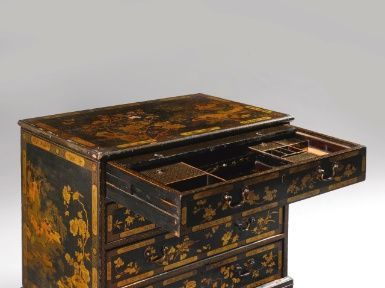26 septembre 2012
A Chinese Export painted black lacquered chest of drawers; probably Canton, late 18th century
A Chinese Export painted black lacquered chest of drawers; probably Canton, late 18th century - Photo Sotheby's
the top drawer with a slide concealing a fitted interior and a hinged ink tray to the right side; 79cm. high, 90.5cm. wide, 57cm. deep; 2ft. 7½in., 2ft. 12¼in., 1ft. 11in. Estimate: 15,000 - 25,000 GBP
CATALOGUE NOTE: This dressing chest is a fine example of the combination of Weste
rn form and Oriental lacquer of the 18th century.
Since the 16th century Oriental lacquer has been highly prized in the West. The art originated in China with the discovery of the protective properties of the sap from the rhus vernifica. This forms a hard and highly durable film which can be applied to wood and provides a smooth surface which can then be gilded, painted or carved.
In response to the Western desire for lacquer, trading companies such as the East India Company were formed with a view to exporting to the West items of lacquer and other popular Oriental items like ceramics. Nanking, Canton and Tonking all became centres for the production of lacquer, and Chinese artisans there were commissioned to produce lacquer objects and pieces of furniture of Western design , such as the present lot, for export. Very often these pieces of furniture were made copying actual examples sent out or from printed European designs.
The majority of lacquer pieces produced at this time tended to be smaller items such as tea caddies, work boxes and small tables because of the difficulties and cost of shipping. Large pieces of furniture tend to be much rarer. Those larger pieces that exist tend to be bureau cabinets, thus making the present lot a particular rarity.
Larger export pieces like the present lot were frequently sent in component form on the sailing clippers that plied the trade routes. In this instance, it would appear that the main construction probably arrived as a solid piece and all the internal fitments were flatpacked and fitted later upon arrival in England.
Few lacquered dressing chests of this form are known to exist. A hardwood example with the combination of writing surface and dressing fitments in the top drawer with a lower drawer fitted inside to contain a washbowl and soap dishes can be seen in the Museum of Art , Rhode Island.
The free style of the foliate decoration, the Oriental landscape vignettes and borders of flowers within Adam style geometric edging on this piece link it to other pieces known to have been produced in Canton in the 18th century. A lacquered kneehole dressing table (illus. Carl Crossman, The Decorative Arts of The China Trade, London, 1997, p.272, pl.149) brought from Canton by Captain William Gray of Salem before 1800, made for either the English or American market and now in the Collection of the Essex Institute, Salem, Massachusetts, shares similar decoration and also has similar English style brassware with swan`s neck handles. A further example of this same group is a desk or poudreuse in the King`s Bedroom at the Royal Pavilion, Brighton.
Sotheby's. Collections. London | 27 Sep 2012 www.sothebys.com
Since the 16th century Oriental lacquer has been highly prized in the West. The art originated in China with the discovery of the protective properties of the sap from the rhus vernifica. This forms a hard and highly durable film which can be applied to wood and provides a smooth surface which can then be gilded, painted or carved.
In response to the Western desire for lacquer, trading companies such as the East India Company were formed with a view to exporting to the West items of lacquer and other popular Oriental items like ceramics. Nanking, Canton and Tonking all became centres for the production of lacquer, and Chinese artisans there were commissioned to produce lacquer objects and pieces of furniture of Western design , such as the present lot, for export. Very often these pieces of furniture were made copying actual examples sent out or from printed European designs.
The majority of lacquer pieces produced at this time tended to be smaller items such as tea caddies, work boxes and small tables because of the difficulties and cost of shipping. Large pieces of furniture tend to be much rarer. Those larger pieces that exist tend to be bureau cabinets, thus making the present lot a particular rarity.
Larger export pieces like the present lot were frequently sent in component form on the sailing clippers that plied the trade routes. In this instance, it would appear that the main construction probably arrived as a solid piece and all the internal fitments were flatpacked and fitted later upon arrival in England.
Few lacquered dressing chests of this form are known to exist. A hardwood example with the combination of writing surface and dressing fitments in the top drawer with a lower drawer fitted inside to contain a washbowl and soap dishes can be seen in the Museum of Art , Rhode Island.
The free style of the foliate decoration, the Oriental landscape vignettes and borders of flowers within Adam style geometric edging on this piece link it to other pieces known to have been produced in Canton in the 18th century. A lacquered kneehole dressing table (illus. Carl Crossman, The Decorative Arts of The China Trade, London, 1997, p.272, pl.149) brought from Canton by Captain William Gray of Salem before 1800, made for either the English or American market and now in the Collection of the Essex Institute, Salem, Massachusetts, shares similar decoration and also has similar English style brassware with swan`s neck handles. A further example of this same group is a desk or poudreuse in the King`s Bedroom at the Royal Pavilion, Brighton.
Sotheby's. Collections. London | 27 Sep 2012 www.sothebys.com
Publicité
Publicité
Commentaires

/https%3A%2F%2Fprofilepics.canalblog.com%2Fprofilepics%2F1%2F0%2F100183.jpg)
/https%3A%2F%2Fstorage.canalblog.com%2F03%2F02%2F119589%2F96711876_o.jpg)
/https%3A%2F%2Fstorage.canalblog.com%2F11%2F31%2F119589%2F94773502_o.jpg)
/https%3A%2F%2Fstorage.canalblog.com%2F20%2F83%2F119589%2F94772815_o.jpg)
/https%3A%2F%2Fstorage.canalblog.com%2F26%2F72%2F119589%2F75604929_o.jpg)
/https%3A%2F%2Fstorage.canalblog.com%2F59%2F60%2F119589%2F26458628_o.jpg)





/http%3A%2F%2Fstorage.canalblog.com%2F21%2F96%2F119589%2F129836760_o.jpg)
/http%3A%2F%2Fstorage.canalblog.com%2F33%2F99%2F119589%2F129627838_o.jpg)
/http%3A%2F%2Fstorage.canalblog.com%2F07%2F83%2F119589%2F129627729_o.jpg)
/http%3A%2F%2Fstorage.canalblog.com%2F28%2F37%2F119589%2F129627693_o.jpg)